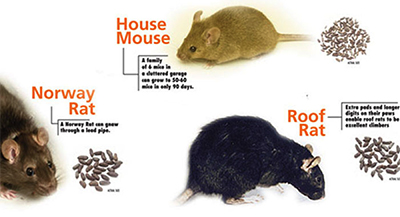|
The Direction of Digestion
The Scoop on Mouse & Rat Poop
By Dr. Stuart Mitchell
Much about mice and reams about rats can be learned by investigating the direction their digestion and the scoop on their poop. Digestion involves all the tissues that contribute to the physical and chemical breakdown of food. Egestion is expelling undigested food from the body in the form of scats.
In a broad sense, the direction on digestion is fairly straightforward.
- Nutrient sensing
- Mechanical digestion
- Chemical digestion or processing
- Egestion
Once located, food must be captured with adaptive anatomy such as mice and rats using forepaws to grasp food and mechanically reducing its size by mastication or use of incisors and molars.
Human foods provide nutritive balance for mice and rats (grains, proteins, and carbohydrates (Corrigan 2015). Mice and rats will consume more moist food on hot days (Corrigan 2015). As omnivorous, ad libitum feeders, mice will consume about 15 g of food and 15 ml of water per 100 g of body weight per day and rats 5 g of food and 10 ml of water per 100 g of body weight per day. As mice and rats have a large surface area to volume, metabolic heat is lost at a greater rate. Therefore nutrient sensing and digestive process is frequent and requires much time and effort.
The surface area to volume ratio changes as the size of the animal changes. As the animal becomes larger (rat vs. mouse), the surface area to volume ratio decreases. For example, if an animal has twice the radius of another, there is four times as much surface area to absorb nutrients or eight times the volume of cells using nutrients. As the animal becomes larger in scale, each cubic millimeter of volume will need to share fewer nutrients gained through digestion (a persistent supply of nutrients). The strategy must change as the size of an animal increases.
Chemical processes are used to convert food fragments into macromolecules and small molecules. Saliva contains enzymes to serve this process. The gastrointestinal (GI) tract is composed of long tubular, branched, enfolded, and enervated smooth muscle that controls the GI shape and food flow, absorptive cells to up-take nutrients, and glands that secrete mucus, acids, ions and enzymes. Undigested food is expelled from the body by egestion in the form of scats.
The scoop on poop is investigated through the science of Scatology. Scatology is the study of feces and coprology. The word is derived from the Greek, skato, meaning “excrement.” Scatological studies allow determination of biological information about mice and rats including diet (what are they feeding on and where have they been), animal health, and disease pathogens.
Tips from our Sponsor

- Age of droppings: New scats are shiny and putty-like in texture, while old scats are hard and crumbly.
- Size of the infestation: Varying feces sizes indicate both juveniles and adults are present vs. several scats indicate a large infestation.
- Activity of area: High activity areas are where rodent management tools should be implemented.
|
|